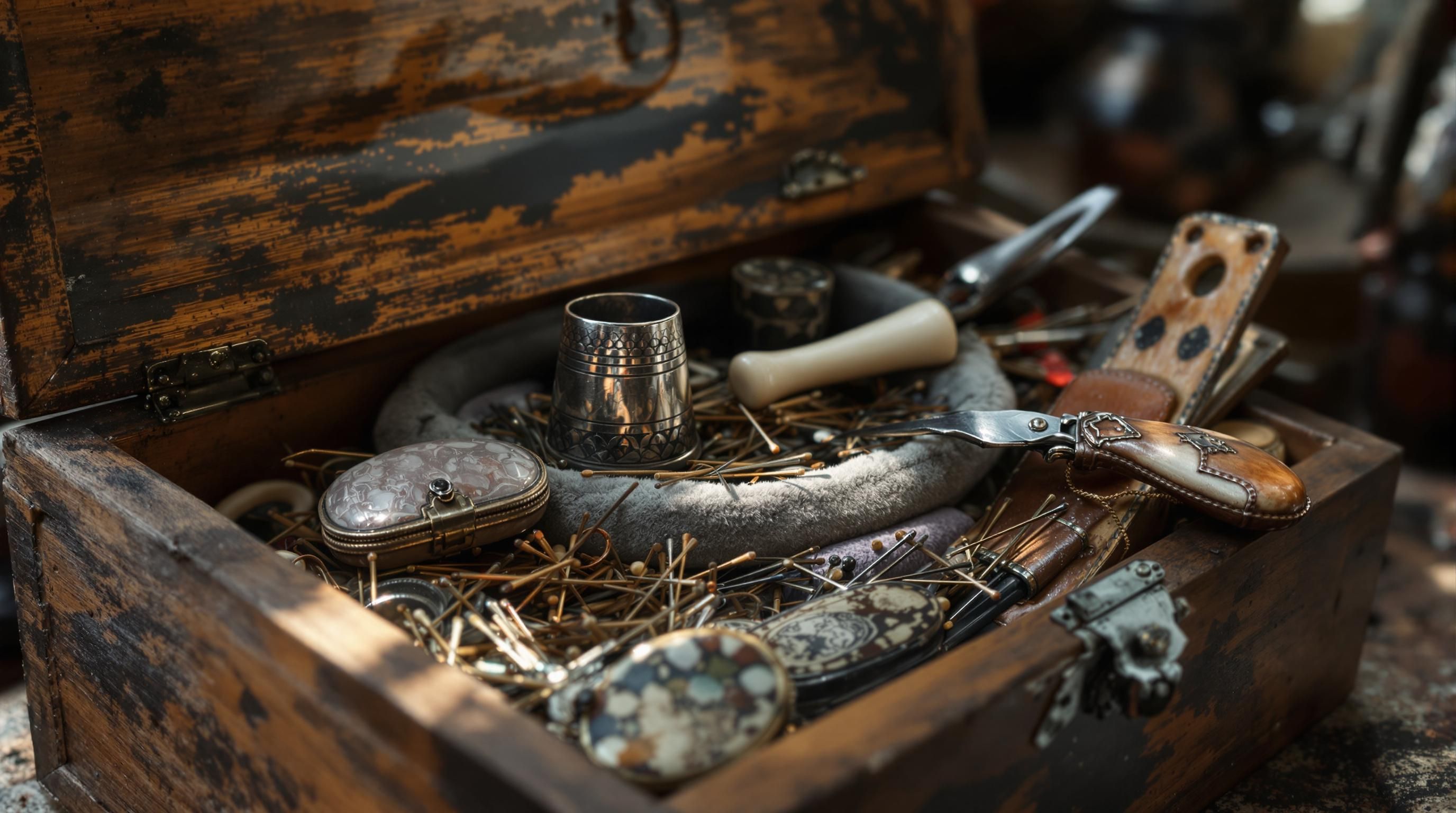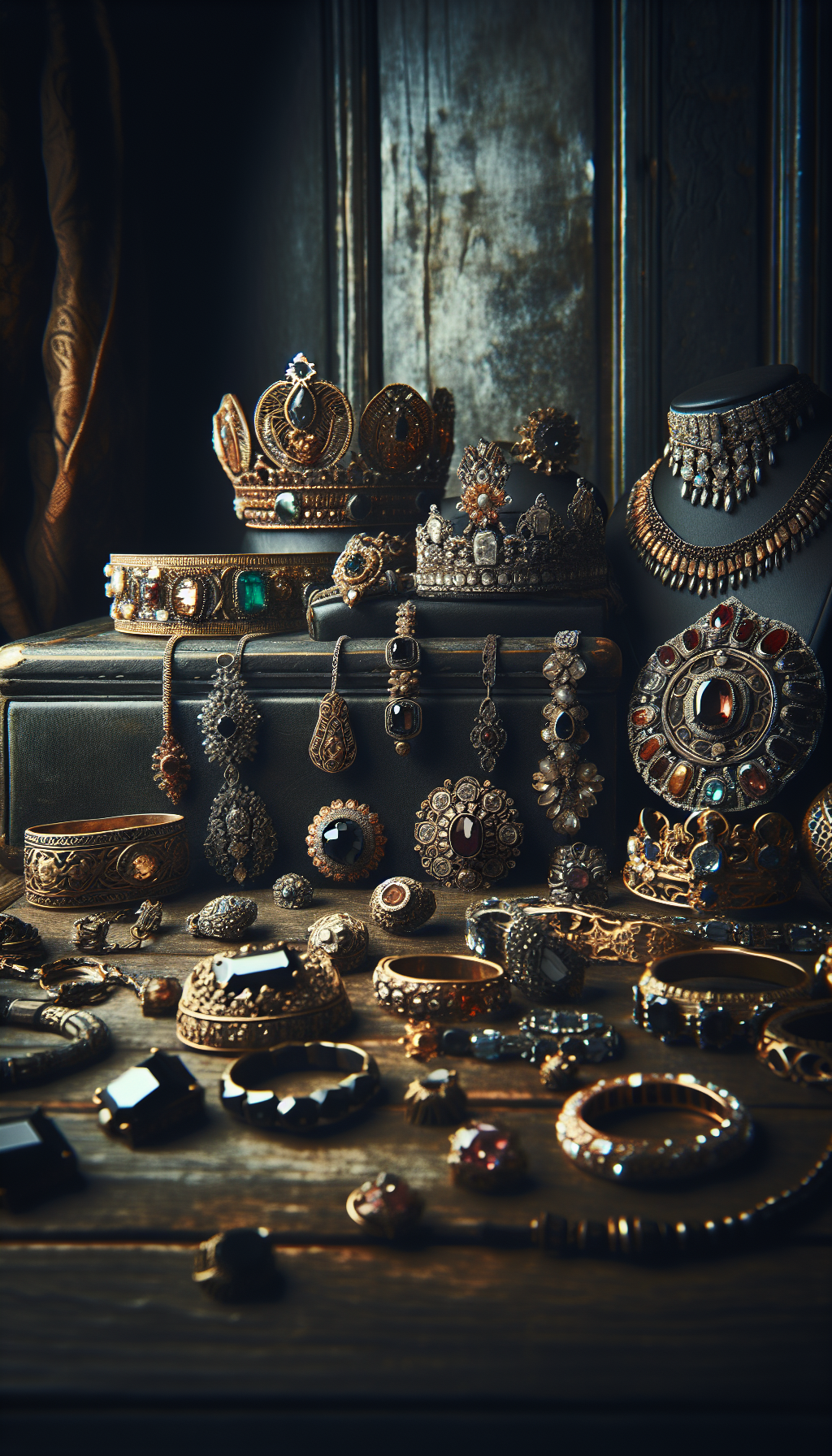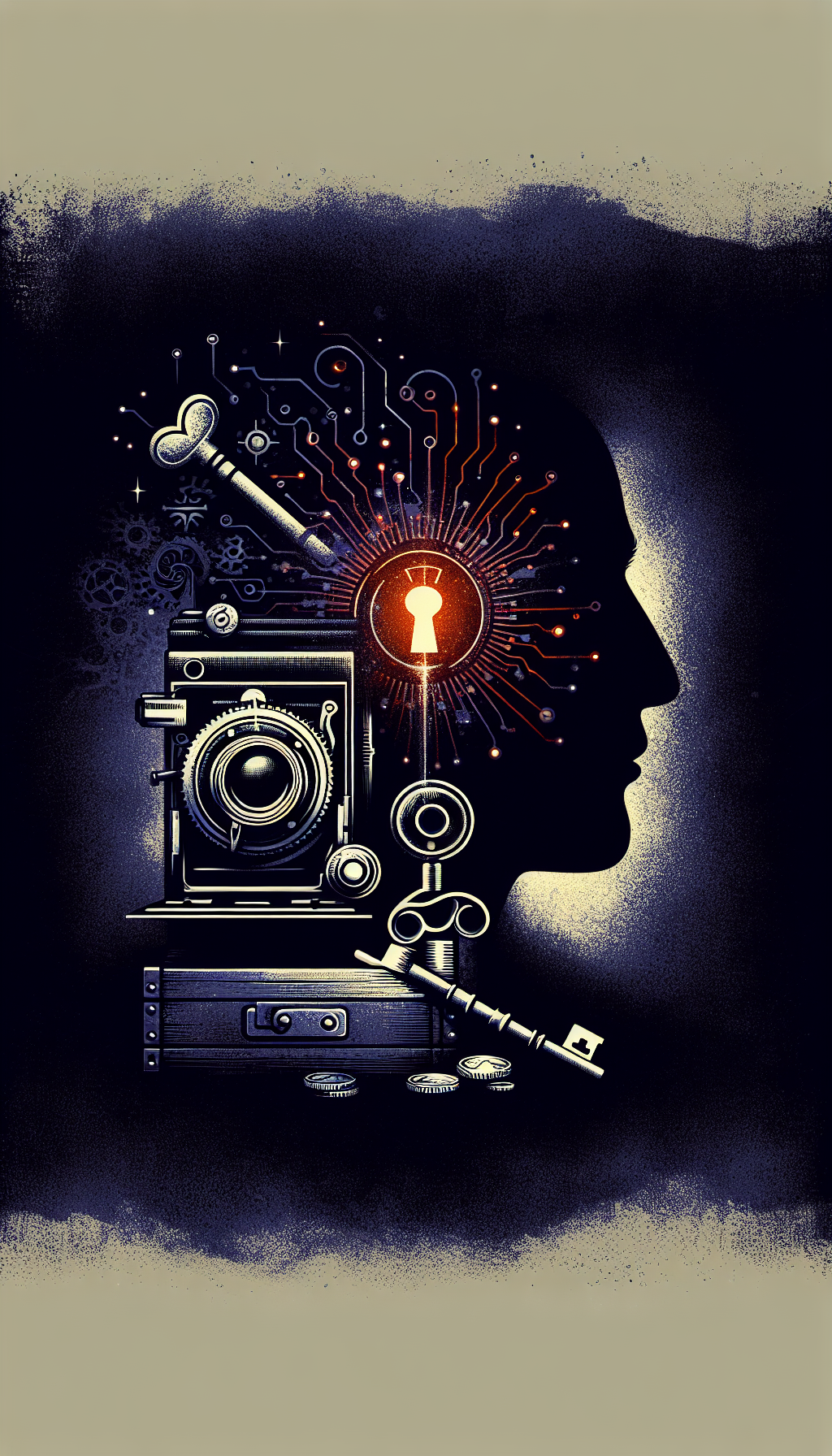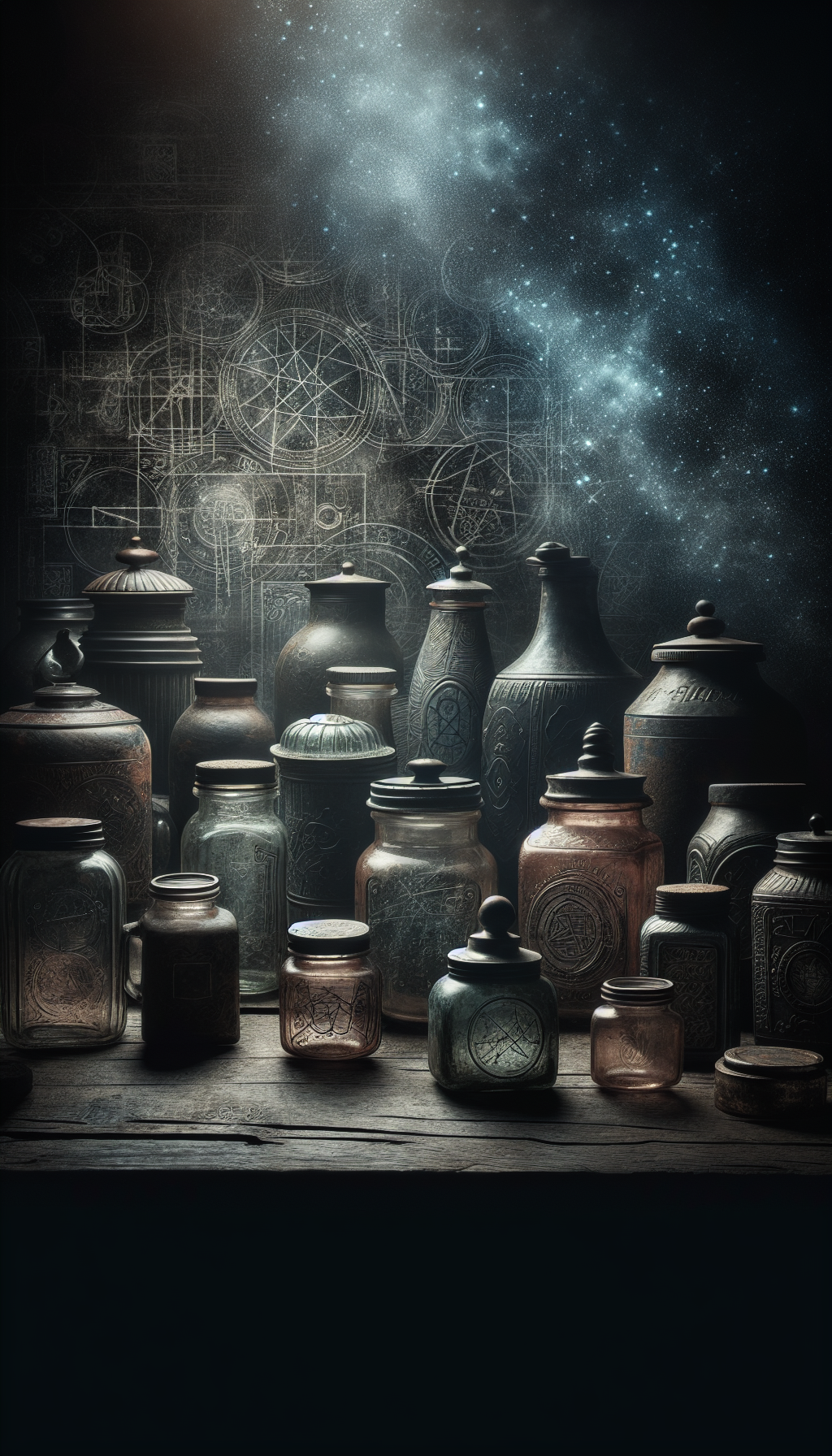Introduction to Antique Sewing Tools
The Rich Heritage of Vintage Sewing Implements
From ornate silver thimbles to intricately carved needle cases, antique sewing tools showcase remarkable craftsmanship that reflects both their functional purpose and the aesthetic sensibilities of their time. These items were not merely utilitarian objects but often served as status symbols and artistic expressions, crafted from precious materials and adorned with elaborate decoration.
Before the era of mass production, sewing implements were frequently handmade by skilled artisans, resulting in unique pieces that tell stories of the past. Understanding how to identify and authenticate these tools opens a window into domestic history while potentially uncovering items of significant collector value.
Antique Sewing Tools Market Insights
Common Types of Antique Sewing Tools
Essential Implements of Historical Needlework
Thimbles
Thimbles are perhaps the most iconic and commonly collected sewing tools. These small protective caps were designed to push needles through fabric without injuring the finger. Antique thimbles were crafted from various materials:
- Silver thimbles: Often hallmarked, allowing for precise dating and maker identification
- Brass and steel thimbles: More utilitarian versions for everyday use
- Porcelain thimbles: Decorative pieces that sometimes served as souvenirs or gifts
- Gold thimbles: Rare luxury items made for wealthy needleworkers
The oldest thimbles date back centuries, with archaeological finds from ancient civilizations. However, most collectible thimbles originate from the 18th through early 20th centuries.
Scissors and Shears
Sewing scissors range from utilitarian cutting tools to ornate works of art. Key types include:
- Embroidery scissors: Small with pointed tips, often shaped like storks or other decorative designs
- Tailor’s shears: Larger tools with offset handles for cutting fabric on flat surfaces
- Button scissors: Specialized tools with rounded tips for slipping under buttons
- Pinking shears: Creates zigzag edges to prevent fabric fraying
Identifying makers such as Wiss, Wilkinson, or Sheffield manufacturers can significantly impact valuation. Look for maker’s marks stamped into the metal near the pivot point.
Needle Cases and Holders
These decorative containers protected valuable needles from damage and loss:
- Etuis: Complete sewing kits housed in decorative cases
- Needle books: Fabric-lined books with pages to store various needle sizes
- Needle cylinders: Tubular cases often made from bone, ivory, or precious metals
- Pincushions: Functional storage that often combined decorative artistry
Needle cases from the Georgian and Victorian eras are particularly sought after, especially those made from silver, mother-of-pearl, or tortoiseshell.
Chatelaines
Worn at the waist, chatelaines served as the original “tool belts” for women:
- Featured hooks and chains from which various sewing implements would hang
- Often included thimble holders, scissors cases, pin cushions, and needle books
- Crafted from silver, steel, or brass with varying degrees of ornamentation
- Most collectible examples date from the mid-19th century
Evolution of Sewing Tools Through History
- Pre-1700s
Early Implements
Handcrafted basic tools including bone needles, simple thimbles, and rudimentary scissors. Most surviving examples are rare museum pieces. - 1700-1800
Georgian Refinement
Rise of silver etuis, decorative thimbles, and sewing boxes. Tools became status symbols with fine craftsmanship for wealthy households. - 1800-1900
Victorian Elaboration
Peak period for decorative sewing tools. Chatelaines became popular, materials diversified, and mass production began alongside handcrafted luxury items. - 1900-1950
Early Modern Period
Industrial manufacturing standardized many tools. Singer and other companies produced branded implements. Art Deco and Art Nouveau influences visible in designs.
Identifying Materials and Manufacturing Techniques
Materials That Tell a Story
Precious Metals
Silver was widely used for high-quality sewing implements, particularly in the 18th and 19th centuries:
- Look for hallmarks indicating silver purity, country of origin, and date
- British silver typically features distinct hallmarks including city marks, date letters, and maker’s marks
- American silver often has simpler “STERLING” or “COIN” markings
- French and German pieces have their own distinctive hallmarking systems
Gold was reserved for the wealthiest patrons, with surviving examples being quite rare and valuable.
Bone, Ivory, and Natural Materials
Prior to modern synthetic materials, natural substances were commonly used:
- Bone: Pale cream color with visible striations and porous ends
- Ivory: Distinctive crosshatch pattern (Schreger lines) visible under magnification
- Mother-of-pearl: Iridescent surface with rainbow-like color play
- Tortoiseshell: Mottled brown pattern with translucent qualities (now regulated due to endangered species protection)
Important note: Regulations such as the Endangered Species Act restrict the sale of ivory and certain other natural materials. Always research current laws before buying or selling such items.
Wood and Early Synthetic Materials
Later examples incorporated:
- Woods: From simple pine to exotic varieties like rosewood
- Celluloid: Early plastic material popular in the late 19th/early 20th centuries, recognizable by its distinctive camphor smell when rubbed
- Bakelite: Hard plastic popular from the 1920s-1940s with characteristic sound when tapped
Manufacturing Techniques
How a piece was crafted offers important dating clues:
- Hand-forged metal shows hammer marks and slight irregularities
- Machine-cut threads on needle cases became standardized after mid-19th century
- Die-stamped decorations replaced hand-engraving in mass-produced items
- Cast metal components replaced individually crafted elements in later pieces
Value Ranges for Antique Sewing Tools
Market values based on recent auction results (2023)
</tbody>
</table>
Dating Techniques for Antique Sewing Tools
Determining the Age of Your Vintage Sewing Implements
Hallmarks and Maker’s Marks
For silver items, hallmarks provide the most precise dating method:
- British silver hallmarking system dates back to the 14th century
- Each hallmark includes symbols for city of origin, date letter, and maker’s mark
- Reference guides like Jackson’s Hallmarks or online databases can help decipher marks
- American silver typically has simpler markings but may include maker’s names
For scissors and steel tools, look for manufacturer stamps:
- “Wiss” indicates the American company operating from the 1840s onward
- “Sheffield” denotes the famous English cutlery manufacturing center
- “Wilkinson” and other maker’s names may be found stamped on quality pieces
Stylistic Elements
Design characteristics often reflect specific periods:
- Georgian (1714-1837): Neoclassical influences, restrained elegance, symmetrical patterns
- Victorian (1837-1901): Ornate decoration, naturalistic motifs, Gothic revival elements
- Art Nouveau (1890-1910): Flowing organic lines, nature-inspired designs
- Art Deco (1920s-1930s): Geometric patterns, bold colors, streamlined forms
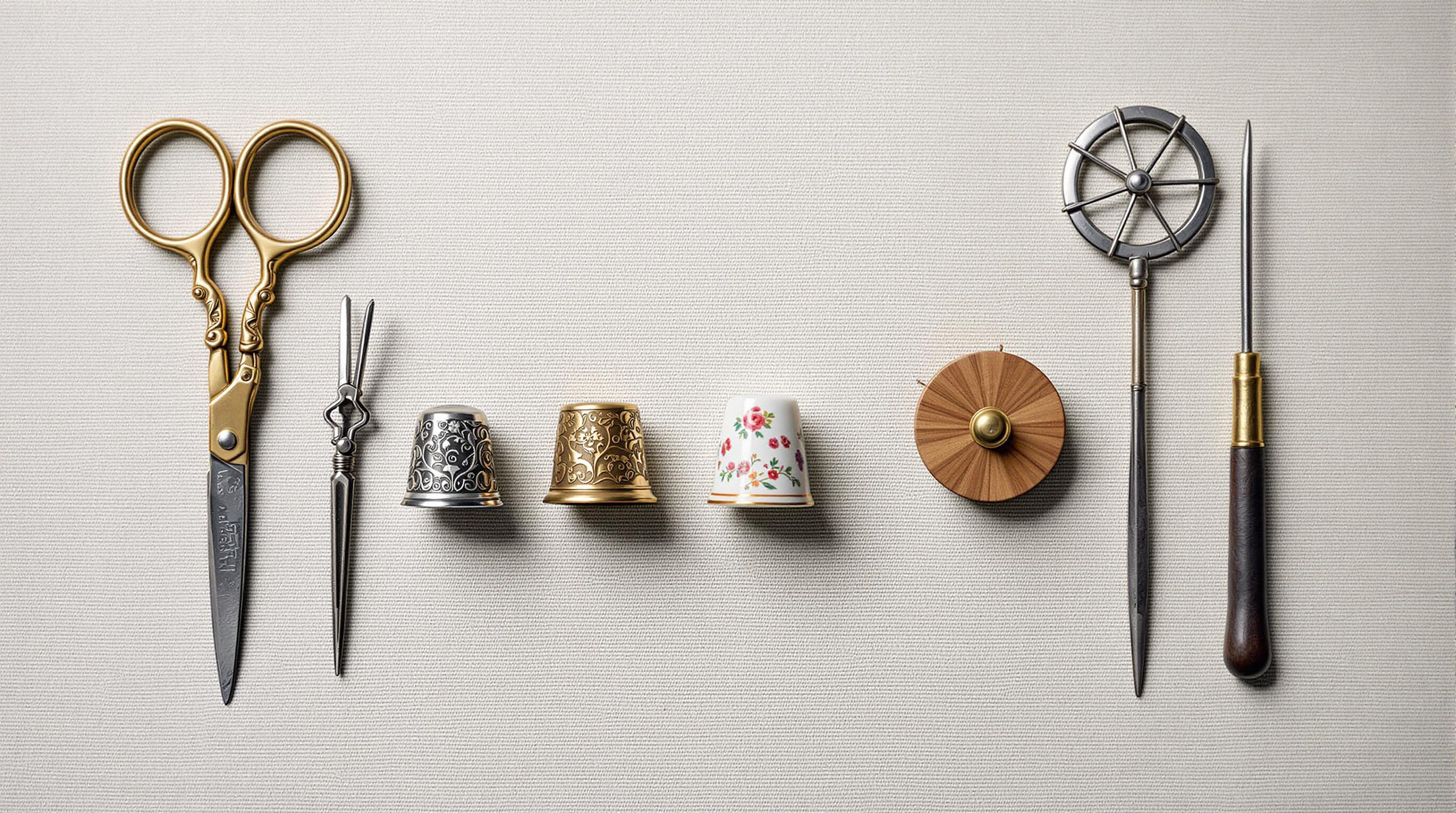
Construction Methods
Manufacturing techniques evolved over time:
- Pre-1800s: Almost entirely handcrafted with visible tool marks
- Early 19th century: Combination of hand and early machine techniques
- Late 19th century: Increased standardization and mass production
- 20th century: Modern manufacturing methods with consistent sizing
Patina and Wear Patterns
Authentic aging provides important authenticating clues:
- Natural tarnish on silver develops differently than artificial aging
- Wear patterns should correspond to actual use (e.g., worn spots on scissor handles where fingers would rest)
- Wood develops specific aging characteristics including color changes and shrinkage
- Metal corrosion should be consistent with age and storage conditions
Authenticity Assessment Checklist
Use this checklist to evaluate whether an antique sewing tool is authentic
- Consistent patina appropriate to claimed age
- Wear patterns match functional use
- Manufacturing techniques match the claimed period
- Hallmarks or maker's marks are authentic and not added later
- Materials are appropriate for the claimed period
- Stylistic elements match known design periods
- No modern materials or adhesives in repairs
- Weight and feel appropriate for claimed materials
Evaluating Condition and Completeness
Understanding How Condition Affects Value
Condition Terminology
Familiarize yourself with standard terms used in the antiques market:
- Mint: Virtually perfect condition with no signs of use or wear
- Excellent: Minor wear consistent with age but no damage
- Very Good: Some wear and minor issues that don’t affect functionality
- Good: Noticeable wear and perhaps minor damage but still complete
- Fair: Significant wear or damage that impacts appearance or function
- Poor: Major problems, missing pieces, or extensive damage
Assessing Sets and Etuis
Complete sets command significant premiums:
- Original etuis (sewing cases) should contain all tools in their proper places
- Check for replaced components that don’t match the original quality or style
- Original fitted compartments often show impressions or wear matching their contents
- Complete chatelaines should retain all hanging implements and chains
Common Condition Issues
Be aware of these typical problems found in antique sewing tools:
- Silver: Dents, splits, repairs, excessive polishing removing detail
- Scissors: Rust, loose pivots, blade damage, mismatched parts
- Needle cases: Broken hinges, missing internal fittings, cracks
- Bone/ivory: Splits, discoloration, improper repairs
Restoration Considerations
Understanding restoration’s impact on value:
- Minor professional conservation generally doesn’t diminish value
- Excessive cleaning or polishing can damage patina and decrease desirability
- Replacement parts should be disclosed and typically reduce value
- Some collectors prefer unrestored original condition even with minor damage
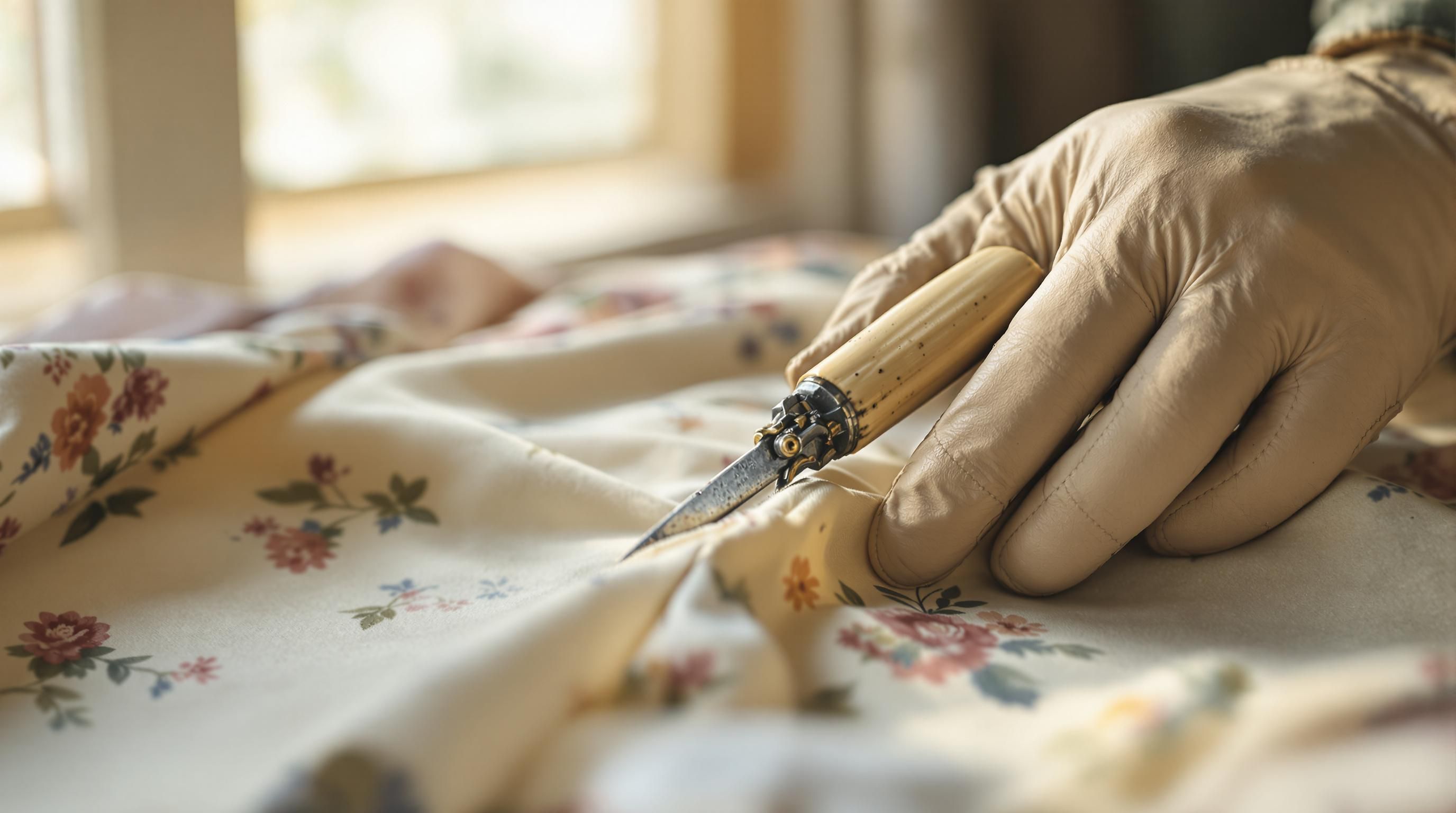
Market Value and Collectibility Factors
What Determines the Value of Antique Sewing Tools
Key Value Drivers
Several characteristics significantly impact worth:
- Rarity: Uncommon items, particularly from earlier periods, command premium prices
- Provenance: Documented history of ownership, especially connections to notable individuals
- Craftsmanship: Exceptional artistic quality or technical execution increases desirability
- Materials: Precious metals and fine materials generally command higher prices
- Maker: Items from renowned manufacturers like Palais Royal or Tiffany & Co. are more valuable
- Completeness: Full sets in original containers are worth substantially more than individual pieces
Market Trends
The collectible sewing tool market has seen several developments in recent years:
- Growing interest in women’s historical artifacts has increased demand
- Online marketplaces have expanded accessibility but also increased buyer competition
- Institutional collectors (museums) actively acquire exceptional examples
- Regulatory changes regarding ivory, tortoiseshell and other materials have impacted certain segments
Where to Buy and Sell
Various venues cater to different segments of the market:
- Specialized antique dealers: Often have the most valuable and rare pieces
- Auction houses: Christie’s, Sotheby’s, and specialist auctioneers regularly feature high-end sewing antiques
- Antique shows: Allow direct examination of items before purchase
- Online platforms: eBay, Etsy, and Ruby Lane offer wide selection but require careful authentication
- Collector groups: Sometimes offer member sales with vetted items
Building a Collection
Strategic approaches for collectors:
- Focus on a specific period, type of tool, or material for a cohesive collection
- Consider condition as a primary factor—premium pieces command increasingly higher prices
- Document provenance and keep records of purchases
- Network with other collectors through organizations like the Thimble Collectors International
Notable Auction Results for Antique Sewing Tools
Exceptional examples sold at major auction houses
| Category | Price | Notes |
|---|---|---|
| Silver thimbles (18th-19th century) | $100-$500 | Higher for hallmarked pieces with maker's marks |
| Decorative embroidery scissors | $75-$300 | Premium for figural designs or known makers |
| Ivory needle cases | $200-$1,000 | Highly variable based on age and carving quality |
| Complete silver etuis | $800-$2,500 | Georgian examples command highest prices |
| Chatelaines | $300-$2,000 | Value increases with complexity and completeness |
| Victorian sewing boxes (complete) | $200-$1,500 | Condition and contents significantly impact value |
</tbody>
</table>
Collecting, Care, and Display
Preserving Your Antique Sewing Treasures
Storage Recommendations
Protect your collection with appropriate storage methods:
- Silver items: Store in acid-free tissue or anti-tarnish cloth bags
- Steel implements: Maintain low humidity and consider silica gel packets for storage containers
- Organic materials: Avoid direct sunlight and maintain stable humidity (40-50%)
- Complete sets: Store in original containers where possible, or in custom-fitted cases
Handling Best Practices
Proper handling prevents damage:
- Always wash and dry hands before handling antique sewing tools
- Pick up silver items by the edges rather than flat surfaces to avoid fingerprints
- Support fragile items fully when moving them
- Wear cotton gloves when handling particularly valuable or delicate pieces
Display Options
Showcase your collection attractively and safely:
- Shadow boxes: Allow visible display while protecting from dust and handling
- Cabinet displays: Traditional method with glass fronts to protect contents
- Museum-style cases: Provide optimal protection for valuable collections
- Original containers: Often the most appropriate and authentic display method
Cleaning and Conservation
Maintain condition without causing damage:
- Silver: Use only specialized silver polish suitable for antiques
- Bone and ivory: Clean with only a soft, slightly damp cloth if necessary
- Fabrics: Consult a textile conservator before attempting any cleaning
- Wood: Apply appropriate conservation waxes sparingly
Consider professional conservation for valuable pieces rather than DIY approaches.
Common Questions About Antique Sewing Tools
What sewing tools were used in the past that we don't commonly see today?
Historical sewing boxes contained many specialized tools unfamiliar to modern sewers:
- Bodkins: Blunt needles used for threading ribbon or cord through casings
- Needle threaders: Often silver or bone implements to assist with threading fine needles
- Stilettos: Pointed tools for making holes in fabric before buttonholes were cut
- Thread winders: Decorative tools for storing thread before the widespread use of spools
- Emeries: Small strawberry or acorn-shaped cushions filled with emery powder for cleaning and sharpening needles
- Tape measures made of cloth with brass ends, often housed in decorative cases
Most of these specialized implements fell out of common use with the advent of sewing machines and mass-produced sewing notions.
How can I tell if my thimble is genuinely antique?
Authenticate an antique thimble by examining these characteristics:
- Look for hallmarks on silver thimbles, which can precisely date the item
- Examine the construction - hand-sewn indentations versus machine-made patterns
- Check the shape - earlier thimbles tend to be taller and narrower
- Assess the wear pattern, which should show genuine use consistent with age
- Evaluate the rim construction - early thimbles often have different rim techniques
Beware of reproductions, particularly of popular patterns like Charles Horner’s "Dorcas" thimbles. When in doubt, consult specialists at organizations like Thimble Collectors International.
What are the most collectible types of antique sewing scissors?
The most sought-after antique scissors include:
- Figural scissors shaped like storks, birds, or other animals (particularly from France and Germany)
- Silver or gold-plated embroidery scissors with ornate handles
- Early steel scissors with maker’s marks from renowned cutlers like Wilkinson
- Scissors in original presentation cases or as part of complete sewing sets
- Specialized forms like grape scissors (adapted for sewing) or pattern-cutting scissors
The value increases significantly when scissors retain sharp blades, smooth action, and original surface finish. Pairs with original sheaths or cases command premium prices.
Are there any regulations I should know about when buying or selling antique sewing tools?
Yes, several regulations impact the antique sewing tool market:
- The Endangered Species Act restricts sale of ivory, tortoiseshell, and certain exotic woods
- CITES (Convention on International Trade in Endangered Species) regulations apply to cross-border transactions
- Some ivory items may qualify for antique exemptions, but documentation requirements are stringent
- Restrictions vary by country, with some nations banning all ivory sales regardless of age
Before purchasing or selling items containing potentially restricted materials, consult current regulations and consider obtaining an appraisal from an expert familiar with these laws.
How can I identify the age of an antique needle case?
Date antique needle cases by examining:
- Materials - bone, ivory, silver, tortoiseshell have specific periods of popularity
- Construction techniques - hand-threading versus machine-cut threads on screw cases
- Decorative elements - floral motifs, engine turning, or pictorial scenes reflect specific periods
- Hallmarks on silver or metal components
- Patina and wear consistent with claimed age
Needle cases from the Georgian period (1714-1837) typically feature more restrained decoration, while Victorian examples (1837-1901) often display more elaborate ornamentation. Early 20th-century examples frequently incorporate materials like celluloid or early plastics.
What is a chatelaine and how can I tell if mine is complete?
A chatelaine is a decorative belt hook or brooch worn at the waist with chains suspended from it, holding useful household tools including sewing implements. Popular during the 19th century, these were both functional and status symbols.To determine completeness:
- Check for the main clasp/hook mechanism that would attach to a belt
- Examine chains for breaks or replacements - original chains should have consistent patina
- Common sewing tools on a complete chatelaine include: thimble case, needle case, scissors in sheath, pin cushion, and sometimes a small notebook or tape measure
- Look for empty rings or attachment points that might indicate missing items
Complete chatelaines are increasingly rare and command significant premiums over incomplete examples. Period photographs or museum examples can help identify what might be missing from your piece.
Authentication and Appraisal
Professional Assessment of Antique Sewing Tools
When to Seek Professional Evaluation
Consider expert assessment in these situations:
- When purchasing high-value items (generally $500+)
- For insurance documentation of valuable collections
- When preparing items for auction or resale
- If you suspect you have a rare or historically significant piece
- For estate valuation and division
Finding Qualified Experts
Seek specialists with appropriate credentials:
- Appraisers: Look for membership in professional organizations (ISA, AAA, USPAP compliance)
- Auction house specialists: Major houses have experts in decorative arts and sewing antiques
- Museum curators: Can provide historical context but typically don’t offer market valuations
- Specialized dealers: Those with long-standing reputations in sewing collectibles
Authentication Process
What to expect during professional examination:
- Visual inspection under various lighting conditions
- Magnification to examine maker’s marks and construction details
- Weight and measurement assessment
- Comparison with reference examples
- Sometimes non-invasive testing methods like UV examination or XRF analysis
Documentation Value
Proper documentation enhances both historical understanding and market value:
- Formal appraisals should include detailed descriptions and value determinations
- Provenance documentation adds historical context and can increase value
- Condition reports establish a baseline for insurance and conservation
- Authentication certificates may be provided for exceptional pieces
External Resources for Antique Sewing Tool Collectors
Collectors Weekly: Antique Sewing Tools
Comprehensive information about antique and vintage sewing tools, including collector stories, identification help, and market trends.
Curio Cabinet Antiques: Sewing Collectibles
Specialist dealer offering a selection of antique sewing tools with detailed descriptions that help collectors learn about identification characteristics.
Two Threads Back: Antique Sewing Tools & Crafts
Historical context and detailed information about 17th-19th century sewing implements, focusing on their cultural significance.
The Journal of Antiques: A Notion to Collect
Comprehensive article on collecting sewing notions including patterns, needles, pins, thimbles, and scissors with guidance on identification.
Antiques Board: Sewing Tools Discussion Forum
Community forum where collectors discuss identification challenges and share knowledge about vintage sewing implements.
YouTube: Vintage Sewing Tools Guide
Video guide to identifying and collecting vintage sewing tools, featuring visual identification tips and market value information.
Conclusion
The world of antique sewing tools offers fascinating insights into domestic history while providing collectors with beautiful objects that represent remarkable craftsmanship from bygone eras. From ornate silver thimbles to intricately carved needle cases, these implements reflect both the practical necessities and artistic sensibilities of their times.
For collectors, the journey of identifying, authenticating, and preserving these historical treasures is rewarding both intellectually and aesthetically. As interest in women’s history and domestic artifacts continues to grow, the market for quality antique sewing implements remains strong, with exceptional pieces commanding increasingly impressive prices.
Whether you’re a seasoned collector or just beginning to explore this fascinating field, developing your knowledge of materials, construction techniques, and historical context will enhance your ability to identify genuine pieces and build a meaningful collection. The resources provided in this guide offer starting points for deeper exploration into this rich collecting category.
By carefully documenting, properly caring for, and thoughtfully displaying these antique sewing tools, collectors help preserve an important aspect of social history while enjoying beautiful objects that connect us to the skilled hands of previous generations.
Get a Professional Appraisal
Unsure about your item’s value? Our certified experts provide fast, written appraisals you can trust.
- Expert report with photos and comps
- Fast turnaround
- Fixed, upfront pricing
No obligation. Secure upload.
| Item | Price | Date | Auction House |
|---|---|---|---|
| Georgian silver etui with complete tools | $3,800 | December 2022 | Christie's London |
| Gold and enamel thimble, circa 1780 | $2,450 | March 2023 | Sotheby's |
| French ivory sewing box with silver tools | $5,200 | September 2022 | Bonhams |
| Victorian silver chatelaine, complete | $4,100 | June 2023 | Heritage Auctions |
